英文阅读材料
- 格式:docx
- 大小:28.62 KB
- 文档页数:16

考研英语阅读素材在准备考研英语的过程中,阅读是提高英语水平和应试能力的关键环节。
阅读不仅能帮助考生扩大词汇量,还能增强对英语语言结构的理解,提升阅读速度和理解能力。
以下是一些精选的考研英语阅读素材,它们涵盖了不同的主题和风格,旨在帮助考生全面提升阅读技能。
首先,考生可以从最新的英文报刊和杂志中选取文章进行阅读。
这些材料通常涵盖了时事、科技、文化、经济等多个领域,能够帮助考生了解全球热点问题和最新发展。
例如,可以阅读《经济学人》、《纽约时报》、《卫报》等知名媒体的文章,这些文章不仅语言地道,而且观点独到,对提高阅读理解能力大有裨益。
其次,学术期刊也是很好的阅读材料。
这些期刊中的文章通常结构严谨,用词准确,能够帮助考生学习到专业的学术表达和论证方式。
例如,可以阅读《自然》、《科学》等顶级学术期刊,这些期刊的文章不仅能够提供丰富的科学知识,还能让考生接触到严谨的学术语言。
此外,文学作品也是考研英语阅读的重要素材。
通过阅读经典小说、诗歌、戏剧等,考生可以提高对文学作品的鉴赏能力,同时学习到丰富的文学表达和修辞手法。
例如,可以阅读简·奥斯汀的《傲慢与偏见》、查尔斯·狄更斯的《双城记》等经典作品,这些作品不仅能够提供深刻的人生哲理,还能让考生体验到英语语言的魅力。
除了上述材料,考生还可以通过阅读英文网站、博客、论坛等获取信息。
这些材料通常语言更加口语化,能够帮助考生了解日常英语的使用和表达方式。
例如,可以浏览BBC Learning English、VOALearning English等英语学习网站,这些网站提供大量的阅读材料和练习,对提高英语阅读能力非常有帮助。
最后,考生在阅读时应该注意培养良好的阅读习惯。
例如,可以定时定量地进行阅读,每天安排一定时间阅读英文材料;在阅读过程中,遇到生词和难句时,要学会使用词典和语法书进行查阅,逐步提高自己的词汇量和语法知识;此外,还可以通过做笔记、写摘要、讨论等方式,加深对阅读材料的理解和记忆。

适合高中生看的英文原版书高中是英语学习的重要阶段,阅读英文原版书不仅可以提高英语水平,还可以开阔视野,丰富思想。
以下是一些适合高中生看的英文原版书:1.《小王子》这是一本充满哲理和人生智慧的童话故事,语言简单易懂,适合高中生阅读。
通过小王子的冒险旅程,读者可以了解到人类的弱点和生命的真谛。
2.《杀死一只知更鸟》这是一本描写美国南方小镇生活的小说,讲述了一个律师父亲为保护无辜黑人孩子,与南方白人社会展开斗争的故事。
这本书的语言简单易懂,故事情节引人入胜,适合高中生阅读。
3.《1984》这是一本反乌托邦小说,描写了一个极权主义国家中人民的生活和思想。
这本书的语言简单易懂,情节引人入胜,适合高中生阅读。
4.《了不起的盖茨比》这是一本描写美国20世纪20年代社会的小说,讲述了一个穷小子变成富豪的故事。
这本书的语言优美,故事情节引人入胜,适合高中生阅读。
5.《哈姆雷特》这是一本描写复仇和阴谋的戏剧作品,是莎士比亚的经典之作。
这本书的语言优美,情节引人入胜,适合高中生阅读。
6.《傲慢与偏见》这是一本描写英国19世纪社会的小说,讲述了一个富家女和穷小子的爱情故事。
这本书的语言优美,故事情节引人入胜,适合高中生阅读。
7.《乌合之众》这是一本社会心理学经典著作,主要探讨群体心理和行为。
这本书的语言简单易懂,理论深入浅出,适合高中生了解人类行为和社会心理学的知识。
8.《麦田里的守望者》这是一本描写青少年内心世界的长篇小说,讲述了一个中学生霍尔顿·考尔菲德在离开学校后的一段经历。
这本书的语言简洁明了,人物形象鲜明,适合高中生了解青少年心理和成长的烦恼。
这些书都有不同的主题和风格,读者可以根据自己的兴趣和爱好选择适合自己的书籍。
在阅读时,可以根据自己的英语水平选择合适的阅读材料,并逐渐提高难度。
同时还可以通过阅读笔记、摘抄好词好句等方式提高阅读效果和英语写作能力。
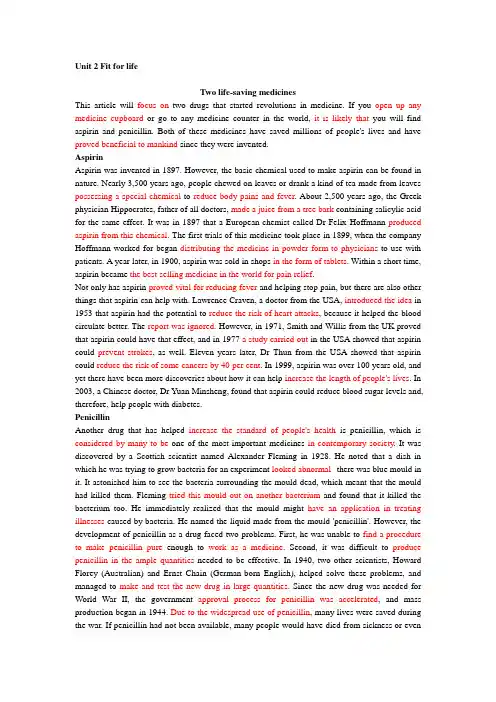
Unit 2 Fit for lifeTwo life-saving medicinesThis article will focus on two drugs that started revolutions in medicine. If you open up any medicine cupboard or go to any medicine counter in the world, it is likely that you will find aspirin and penicillin. Both of these medicines have saved millions of people's lives and have proved beneficial to mankind since they were invented.AspirinAspirin was invented in 1897. However, the basic chemical used to make aspirin can be found in nature. Nearly 3,500 years ago, people chewed on leaves or drank a kind of tea made from leaves possessing a special chemical to reduce body pains and fever. About 2,500 years ago, the Greek physician Hippocrates, father of all doctors, made a juice from a tree bark containing salicylic acid for the same effect. It was in 1897 that a European chemist called Dr Felix Hoffmann produced aspirin from this chemical. The first trials of this medicine took place in 1899, when the company Hoffmann worked for began distributing the medicine in powder form to physicians to use with patients. A year later, in 1900, aspirin was sold in shops in the form of tablets. Within a short time, aspirin became the best-selling medicine in the world for pain relief.Not only has aspirin proved vital for reducing fever and helping stop pain, but there are also other things that aspirin can help with. Lawrence Craven, a doctor from the USA, introduced the idea in 1953 that aspirin had the potential to reduce the risk of heart attacks, because it helped the blood circulate better. The report was ignored. However, in 1971, Smith and Willis from the UK proved that aspirin could have that effect, and in 1977 a study carried out in the USA showed that aspirin could prevent strokes, as well. Eleven years later, Dr Thun from the USA showed that aspirin could reduce the risk of some cancers by 40 per cent. In 1999, aspirin was over 100 years old, and yet there have been more discoveries about how it can help increase the length of people's lives. In 2003, a Chinese doctor, Dr Y uan Minsheng, found that aspirin could reduce blood sugar levels and, therefore, help people with diabetes.PenicillinAnother drug that has helped increase the standard of people's health is penicillin, which is considered by many to be one of the most important medicines in contemporary society. It was discovered by a Scottish scientist named Alexander Fleming in 1928. He noted that a dish in which he was trying to grow bacteria for an experiment looked abnormal--there was blue mould in it. It astonished him to see the bacteria surrounding the mould dead, which meant that the mould had killed them. Fleming tried this mould out on another bacterium and found that it killed the bacterium too. He immediately realized that the mould might have an application in treating illnesses caused by bacteria. He named the liquid made from the mould 'penicillin'. However, the development of penicillin as a drug faced two problems. First, he was unable to find a procedure to make penicillin pure enough to work as a medicine. Second, it was difficult to produce penicillin in the ample quantities needed to be effective. In 1940, two other scientists, Howard Florey (Australian) and Ernst Chain (German-born English), helped solve these problems, and managed to make and test the new drug in large quantities. Since the new drug was needed for World War II, the government approval process for penicillin was accelerated, and mass production began in 1944. Due to the widespread use of penicillin, many lives were saved during the war. If penicillin had not been available, many people would have died from sickness or evensmall wounds. Penicillin became the greatest drug of the 20th century, saving millions of lives.In 1945, the three scientists, Fleming, Florey and Chain, shared the Nobel Prize in Medicine for their work.Magic needles: Chinese acupunctureOne of the most famous Chinese medical treatments is the art of 'magic needles', or Chinese acupuncture. It was developed long ago, perhaps as early as 2000 BC. There is evidence that acupuncture began during the Stone Age, when stone tools called bian (砭) were used to press areas of the body.As acupuncture developed, the simple bian stones were replaced by stone needles. Eventually, metal needles began to appear and took their place. There were nine different kinds of needles. These included a needle with a head like an arrow, used for making shallow holes in the surface of the skin; a needle with a round tip, used for pressing the tissue under the skin; a dull needle, used for tapping against pressure points; and a needle like a small sword, used for letting liquid out of body parts which had swollen up. These needles could be made of different metals, such as gold and silver. Some acupuncturists today still use gold and silver needles, but the majority use only stainless steel ones. The main needle now used for acupuncture is fine and sharp. Most of the others have been replaced by more complex medical instruments. For example, the needle looking like a sword has been replaced by a sharp knife that doctors use in operations.Acupuncture uses stainless steel needles that are put into the skin at certain points on the body so that a disease can be cured or a health problem solved. These points are called acupuncture points. When acupuncture was first practised, there were 365 such points. The number of acupuncture points was the same as the number of days in a year. However, over the last 2,000 years, this number has gradually increased to about 2,000. Some acupuncturists insert needles at or near the body part affected by the disease, while others select points according to the symptoms that the patient has.If you go to an acupuncturist, he or she will ask you questions about your medical history and your way of life. The acupuncturist will look at the colour of your skin and your tongue, listen to your breathing, and check your pulses.Western medicine only recognizes one pulse which indicates the heartbeat. However, according to traditional Chinese medicine, there are twelve different pulses, six on each wrist, and every one of them is connected with a major body organ or its function. By checking all the pulses, the acupuncturist can find out which energy channel does not have enough energy.Some of the medical problems that can be treated by acupuncture include severe pains, headaches, injuries, stomach problems and high blood pressure. Some people have also used acupuncture to treat smokers, alcoholics and people who are addicted to drugs.How acupuncture reduces pain is not clear. One theory explaining this phenomenon suggests that acupuncture blocks pain signals from reaching the brain. Another theory relates acupuncture to the production of chemicals in the body which reduce pain. A lot of people now subscribe to these theories.As a unique contribution of traditional Chinese medicine, acupuncture spread to many other Asian countries, such as Japan, as early as the 6th century. It was introduced to the West in the 17thcentury. Today acupuncture has become popular round the world, as have other traditional Chinese medicines. The World Health Organization recommends acupuncture as a good treatment for over forty medical problems. While doubts about its safety have faded away, interest continues to grow.两种挽救生命的药物这篇文章将着重讲述两种引发了医学革命的药物。
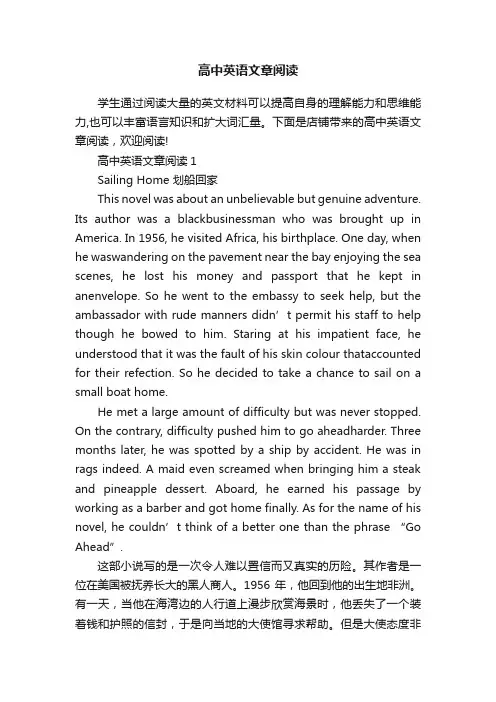
高中英语文章阅读学生通过阅读大量的英文材料可以提高自身的理解能力和思维能力,也可以丰富语言知识和扩大词汇量。
下面是店铺带来的高中英语文章阅读,欢迎阅读!高中英语文章阅读1Sailing Home 划船回家This novel was about an unbelievable but genuine adventure. Its author was a blackbusinessman who was brought up in America. In 1956, he visited Africa, his birthplace. One day, when he waswandering on the pavement near the bay enjoying the sea scenes, he lost his money and passport that he kept in anenvelope. So he went to the embassy to seek help, but the ambassador with rude manners didn’t permit his staff to help though he bowed to him. Staring at his impatient face, he understood that it was the fault of his skin colour thataccounted for their refection. So he decided to take a chance to sail on a small boat home.He met a large amount of difficulty but was never stopped. On the contrary, difficulty pushed him to go aheadharder. Three months later, he was spotted by a ship by accident. He was in rags indeed. A maid even screamed when bringing him a steak and pineapple dessert. Aboard, he earned his passage by working as a barber and got home finally. As for the name of his novel, he couldn’t think of a better one than the phrase “Go Ahead”.这部小说写的是一次令人难以置信而又真实的历险。
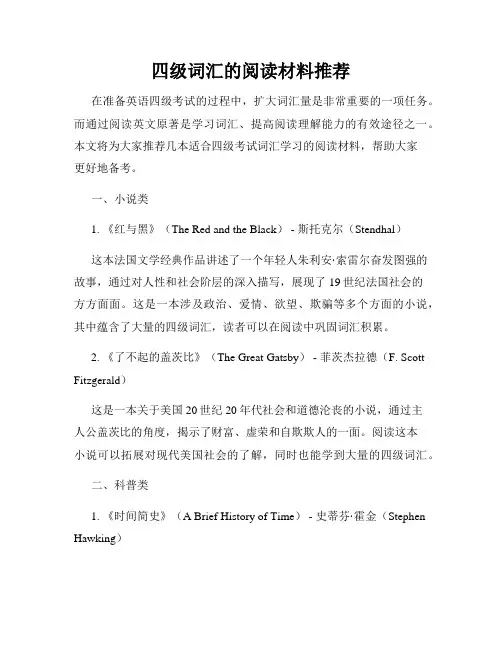
四级词汇的阅读材料推荐在准备英语四级考试的过程中,扩大词汇量是非常重要的一项任务。
而通过阅读英文原著是学习词汇、提高阅读理解能力的有效途径之一。
本文将为大家推荐几本适合四级考试词汇学习的阅读材料,帮助大家更好地备考。
一、小说类1. 《红与黑》(The Red and the Black) - 斯托克尔(Stendhal)这本法国文学经典作品讲述了一个年轻人朱利安·索雷尔奋发图强的故事,通过对人性和社会阶层的深入描写,展现了19世纪法国社会的方方面面。
这是一本涉及政治、爱情、欲望、欺骗等多个方面的小说,其中蕴含了大量的四级词汇,读者可以在阅读中巩固词汇积累。
2. 《了不起的盖茨比》(The Great Gatsby) - 菲茨杰拉德(F. Scott Fitzgerald)这是一本关于美国20世纪20年代社会和道德沦丧的小说,通过主人公盖茨比的角度,揭示了财富、虚荣和自欺欺人的一面。
阅读这本小说可以拓展对现代美国社会的了解,同时也能学到大量的四级词汇。
二、科普类1. 《时间简史》(A Brief History of Time) - 史蒂芬·霍金(Stephen Hawking)这本书由著名物理学家霍金所著,以浅显易懂的语言讲述了宇宙、时间、黑洞等深奥的物理知识。
虽然涉及一些专业名词,但是通过阅读这本书,可以帮助读者掌握相关的科学词汇,并了解一些基础的物理概念。
2. 《流浪地球》 - 刘慈欣这是一本中国科幻作家刘慈欣的长篇小说,讲述了人类为了逃离即将毁灭的地球而展开的银河流浪的故事。
通过阅读这本小说,读者可以学到一些科技、太空、生态等方面的词汇,同时也能感受到作者对未来的思考和展望。
三、历史类1. 《杀死一只知更鸟》(To Kill a Mockingbird) - 哈珀·李(Harper Lee)这本美国文学经典作品描述了20世纪30年代美国南方小镇的种族歧视和社会不公问题,通过一个女孩的视角展示了成长与正义的故事。
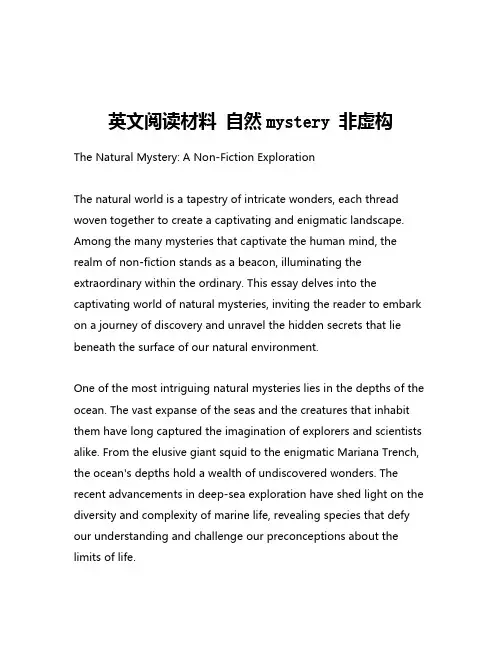
英文阅读材料自然mystery 非虚构The Natural Mystery: A Non-Fiction ExplorationThe natural world is a tapestry of intricate wonders, each thread woven together to create a captivating and enigmatic landscape. Among the many mysteries that captivate the human mind, the realm of non-fiction stands as a beacon, illuminating the extraordinary within the ordinary. This essay delves into the captivating world of natural mysteries, inviting the reader to embark on a journey of discovery and unravel the hidden secrets that lie beneath the surface of our natural environment.One of the most intriguing natural mysteries lies in the depths of the ocean. The vast expanse of the seas and the creatures that inhabit them have long captured the imagination of explorers and scientists alike. From the elusive giant squid to the enigmatic Mariana Trench, the ocean's depths hold a wealth of undiscovered wonders. The recent advancements in deep-sea exploration have shed light on the diversity and complexity of marine life, revealing species that defy our understanding and challenge our preconceptions about the limits of life.Another fascinating natural mystery lies in the realm of cryptozoology – the study of creatures whose existence has not been scientifically verified. From the legendary Bigfoot to the enigmatic Loch Ness Monster, these mysterious beings have captivated the public's imagination for centuries. While some may dismiss these creatures as mere myths, the persistent sightings and tantalizing evidence have sparked the curiosity of researchers and enthusiasts alike. The pursuit of these unknown creatures has led to the discovery of new species and the reevaluation of our understanding of the natural world.The natural world is also home to a myriad of unsolved phenomena that defy our current scientific understanding. The unexplained disappearances of entire civilizations, such as the Roanoke Colony in North America, have puzzled historians and archaeologists for generations. The mysterious crop circles that appear in fields around the world have also captured the public's attention, with theories ranging from extraterrestrial activity to complex hoaxes. These unsolved mysteries serve as a reminder that there is still much to be discovered and understood about the natural world and its hidden secrets.One of the most captivating natural mysteries is the phenomenon of bioluminescence – the production of light by living organisms. From the glowing plankton that illuminate the oceans to the fireflies thatdance in the night sky, bioluminescence is a mesmerizing display of the natural world's ability to create light. Scientists have long studied the mechanisms behind this phenomenon, uncovering the complex biochemical processes that allow certain organisms to produce their own light. However, the full extent of bioluminescence in nature and its evolutionary significance remains a subject of ongoing research and exploration.Another intriguing natural mystery is the migration patterns of various species, particularly birds and marine animals. The ability of these creatures to navigate vast distances, often across continents or oceans, has long fascinated scientists and naturalists. The complex mechanisms that guide these migratory journeys, from the use of celestial cues to the perception of magnetic fields, continue to be a subject of intense study and debate. Understanding these migration patterns is not only a scientific pursuit but also crucial for the conservation of these remarkable species.The natural world is also home to a wealth of unexplained geological phenomena, such as the mysterious fairy circles found in various regions around the world. These circular patterns of bare earth, devoid of vegetation, have been observed in several arid and semi-arid regions, and their origins have been the subject of much speculation. Theories range from the influence of termites and other soil organisms to the possibility of supernatural or extraterrestrialforces. As scientists continue to investigate these enigmatic formations, they may uncover insights into the complex interactions between living organisms and the Earth's surface.In addition to these natural mysteries, the field of paleontology has also yielded a wealth of intriguing discoveries. The unearthing of fossils and the study of ancient life forms have revealed a wealth of information about the history of our planet and the evolution of life. However, many questions remain unanswered, such as the causes of mass extinctions, the emergence of new species, and the evolution of complex life forms. The ongoing search for fossils and the continued study of these ancient remains promise to uncover even more mysteries about the past and the processes that have shaped the natural world as we know it.Throughout this exploration of natural mysteries, it becomes evident that the natural world is a tapestry of wonders, each thread representing a captivating and enigmatic phenomenon. From the depths of the ocean to the heights of the sky, the natural world continues to challenge our understanding and fuel our curiosity. As we delve deeper into these mysteries, we not only uncover new insights about the world around us but also gain a deeper appreciation for the complexity and beauty of the natural realm. The pursuit of these natural mysteries is not merely an academic exercisebut a journey of wonder and discovery that holds the potential to transform our understanding of the world we inhabit.。
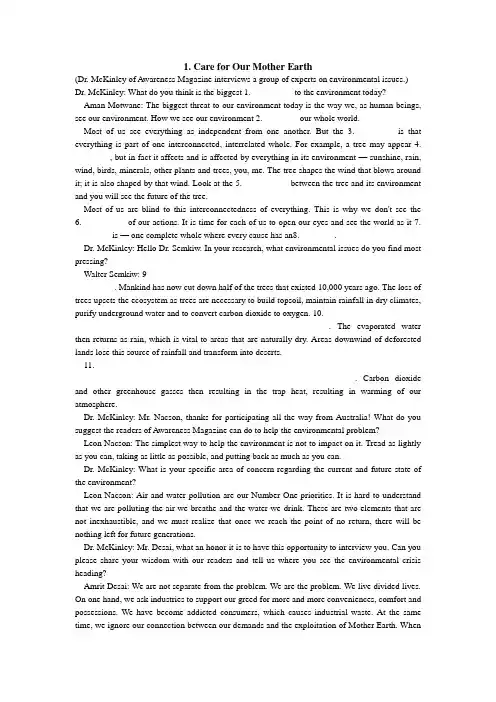
1. Care for Our Mother Earth(Dr. McKinley of Awareness Magazine interviews a group of experts on environmental issues.) Dr. McKinley: What do you think is the biggest 1. _________ to the environment today?Aman Motwane: The biggest threat to our environment today is the way we, as human beings, see our environment. How we see our environment 2.________ our whole world.Most of us see everything as independent from one another. But the 3. ________ is that everything is part of one interconnected, interrelated whole. For example, a tree may appear 4. ________, but in fact it affects and is affected by everything in its environment — sunshine, rain, wind, birds, minerals, other plants and trees, you, me. The tree shapes the wind that blows around it; it is also shaped by that wind. Look at the 5. __________ between the tree and its environment and you will see the future of the tree.Most of us are blind to this interconnectedness of everything. This is why we don't see the 6.__________ of our actions. It is time for each of us to open our eyes and see the world as it 7. ________ is — one complete whole where every cause has an8.________.Dr. McKinley: Hello Dr. Semkiw. In your research, what environmental issues do you find most pressing?Walter Semkiw: 9____________________________________________________________________. Mankind has now cut down half of the trees that existed 10,000 years ago. The loss of trees upsets the ecosystem as trees are necessary to build topsoil, maintain rainfall in dry climates, purify underground water and to convert carbon dioxide to oxygen. 10. ___________________________________________________________________________. The evaporated water then returns as rain, which is vital to areas that are naturally dry. Areas downwind of deforested lands lose this source of rainfall and transform into deserts.11.__________________________________________________________________________ ________________________________________________________________. Carbon dioxide and other greenhouse gasses then resulting in the trap heat, resulting in warming of our atmosphere.Dr. McKinley: Mr. Nacson, thanks for participating all the way from Australia! What do you suggest the readers of Awareness Magazine can do to help the environmental problem?Leon Nacson: The simplest way to help the environment is not to impact on it. Tread as lightly as you can, taking as little as possible, and putting back as much as you can.Dr. McKinley: What is your specific area of concern regarding the current and future state of the environment?Leon Nacson: Air and water pollution are our Number One priorities. It is hard to understand that we are polluting the air we breathe and the water we drink. These are two elements that are not inexhaustible, and we must realize that once we reach the point of no return, there will be nothing left for future generations.Dr. McKinley: Mr. Desai, what an honor it is to have this opportunity to interview you. Can you please share your wisdom with our readers and tell us where you see the environmental crisis heading?Amrit Desai: We are not separate from the problem. We are the problem. We live divided lives. On one hand, we ask industries to support our greed for more and more conveniences, comfort and possessions. We have become addicted consumers, which causes industrial waste. At the same time, we ignore our connection between our demands and the exploitation of Mother Earth. Whenwe are greedy for more than what we need for our well being, we always abuse the resources of our body and the earth.We are nurtured by the healthy condition of Mother Earth. In humans, if the mother is ailing, the child suffers. We are the cause of the ailing planet and we are the victims.Dr. McKinley: In closing, I thank all of the participants. I have learned a great deal about what I can do as an individual to help the environment.I hope these interviews encourage the readers of Awareness Magazine to take action and develop your own strategy. Too many of us just sit back and say "I'll let the experts deal with it." Meanwhile, we are killing the planet. My aim of this interview is to show how one person can make a difference. Thanks to all for offering your wisdom. (731 words)I. Choose the best answer to each question based on the information you obtain from the passage.1. It can be concluded from the passage that ______.A) fossils fuel are the only cause of global warmingB) trees play an important role in avoiding global warmingC) the interview is held in AustraliaD) experts do not have a solution to the environmental crisis2. By saying that "the biggest threat to our environment today is the way we see our environment" (line 2-3), Aman Motwane implies that ______.A) everything in the ecosystem is part of one complete wholeB) most people hold a wrong view on the environmentC) everything affects and is affected by its environmentD) people are indifferent to the environment protection3. In Leon Nacson's view, air and water pollution are our Number One priorities because ______.A) he cannot understand why people are polluting air and waterB) there will be nothing left for future generationsC) we would run out of air and water if we didn't stop polluting themD) air and water pollution are the current and future state of the environment4. TWhich of the following best explains Amrit Desai's words "we live divided lives"?A) We pollute Mother Earth in pursuing a better life, which, consequently, hurts ourselves.B) We are never satisfied with what we have, and we do not make good use of natural resources.C) If Mother Earth is ill, we, as her children, only enjoy part of our life.D) Though we have created the environmental problem, we try to separate ourselves from it.5. According to Dr. McKinley, what is the root cause of the environmental problem?A) Deforesting and global warming.B) The abuse of natural resources.C) Air and water pollution.D) The attitude of human beings.II. Translate the following sentences into English.1. 这场给人类带来巨大灾难的战争对这样一个诗人产生了什么影响呢?(impact on)2. 做母亲的有时候不能察觉她们所宠爱的孩子们的过错,这样做的结果会使孩子们再次犯同样的过错。
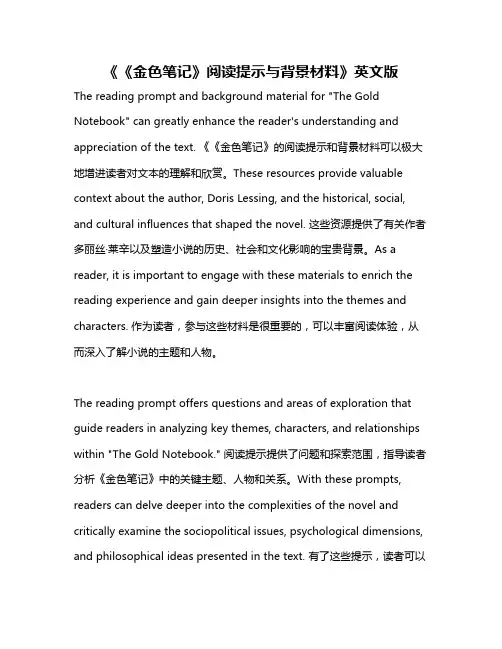
《《金色笔记》阅读提示与背景材料》英文版The reading prompt and background material for "The Gold Notebook" can greatly enhance the reader's understanding and appreciation of the text. 《《金色笔记》的阅读提示和背景材料可以极大地增进读者对文本的理解和欣赏。
These resources provide valuable context about the author, Doris Lessing, and the historical, social, and cultural influences that shaped the novel. 这些资源提供了有关作者多丽丝·莱辛以及塑造小说的历史、社会和文化影响的宝贵背景。
As a reader, it is important to engage with these materials to enrich the reading experience and gain deeper insights into the themes and characters. 作为读者,参与这些材料是很重要的,可以丰富阅读体验,从而深入了解小说的主题和人物。
The reading prompt offers questions and areas of exploration that guide readers in analyzing key themes, characters, and relationships within "The Gold Notebook." 阅读提示提供了问题和探索范围,指导读者分析《金色笔记》中的关键主题、人物和关系。

人教版小学英语必背英文单词及阅读材料
集锦
这份文档将为您提供一些人教版小学英语必背的英文单词以及
一些阅读材料供您参考。
以下是一些常用的英文单词及其中文意思,帮助您扩大词汇量和提高英语水平。
英文单词
1. apple - 苹果
2. book - 书
3. cat - 猫
4. dog - 狗
5. elephant - 大象
6. fish - 鱼
7. girl - 女孩
8. hat - 帽子
9. ice cream - 冰淇淋
10. juice - 果汁
请注意,这只是一小部分英文单词列表,您可以根据需要继续扩展。
阅读材料
小猫喜欢玩耍
小猫喜欢玩耍。
它喜欢追逐小鸟和蝴蝶。
它也喜欢跳上跳下,给人们带来欢乐。
那是我最爱的花
这是一朵漂亮的花。
它有五个花瓣,呈现出五彩斑斓的颜色。
每当我看到它时,心情都变得特别好。
我的新朋友
昨天,我在公园里碰到了一个新朋友。
他是个快乐的男孩,我们一起玩得很开心。
我很高兴交到了一个新朋友。
请注意,这些阅读材料是简短的,适合小学生阅读。
希望这些英文单词和阅读材料对您有帮助!如果您需要更多的单词或者阅读材料,请随时告诉我们。
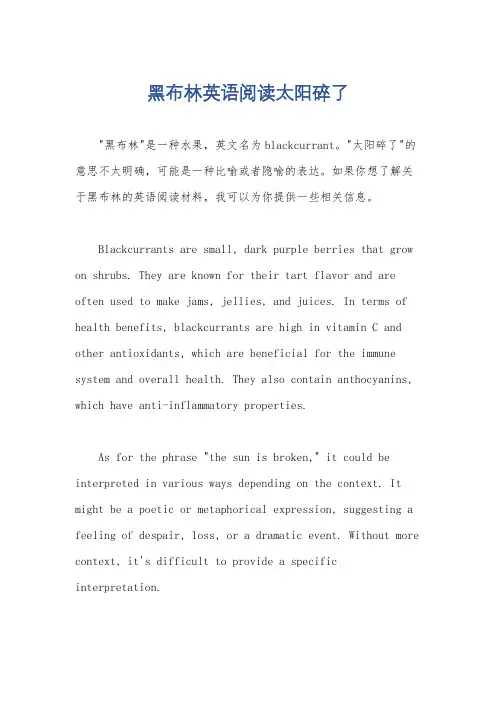
黑布林英语阅读太阳碎了"黑布林"是一种水果,英文名为blackcurrant。
"太阳碎了"的意思不太明确,可能是一种比喻或者隐喻的表达。
如果你想了解关于黑布林的英语阅读材料,我可以为你提供一些相关信息。
Blackcurrants are small, dark purple berries that grow on shrubs. They are known for their tart flavor and are often used to make jams, jellies, and juices. In terms of health benefits, blackcurrants are high in vitamin C and other antioxidants, which are beneficial for the immune system and overall health. They also contain anthocyanins, which have anti-inflammatory properties.As for the phrase "the sun is broken," it could be interpreted in various ways depending on the context. It might be a poetic or metaphorical expression, suggesting a feeling of despair, loss, or a dramatic event. Without more context, it's difficult to provide a specific interpretation.If you have a specific context or more details about what you are looking for, please feel free to provide additional information so that I can offer a more targeted and comprehensive response.。
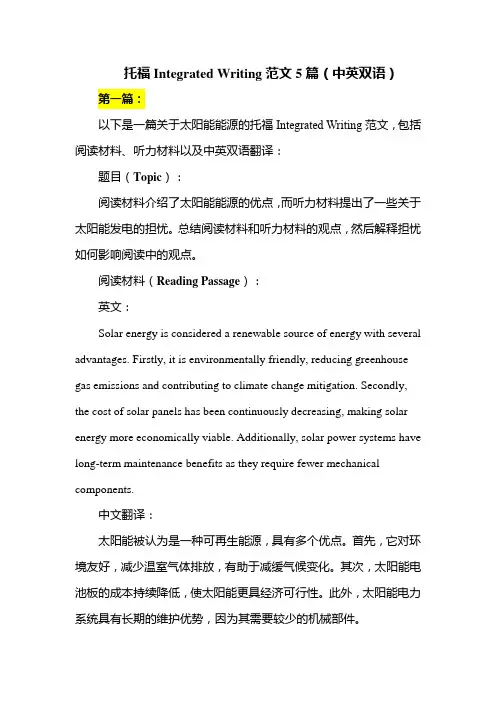
托福Integrated Writing范文5篇(中英双语)第一篇:以下是一篇关于太阳能能源的托福Integrated Writing范文,包括阅读材料、听力材料以及中英双语翻译:题目(Topic):阅读材料介绍了太阳能能源的优点,而听力材料提出了一些关于太阳能发电的担忧。
总结阅读材料和听力材料的观点,然后解释担忧如何影响阅读中的观点。
阅读材料(Reading Passage):英文:Solar energy is considered a renewable source of energy with several advantages. Firstly, it is environmentally friendly, reducing greenhouse gas emissions and contributing to climate change mitigation. Secondly, the cost of solar panels has been continuously decreasing, making solar energy more economically viable. Additionally, solar power systems have long-term maintenance benefits as they require fewer mechanical components.中文翻译:太阳能被认为是一种可再生能源,具有多个优点。
首先,它对环境友好,减少温室气体排放,有助于减缓气候变化。
其次,太阳能电池板的成本持续降低,使太阳能更具经济可行性。
此外,太阳能电力系统具有长期的维护优势,因为其需要较少的机械部件。
听力材料(Listening Passage):英文:However, some concerns have been raised regarding solar power generation systems. It is argued that the manufacturing of solar panels may result in the emission of harmful chemicals, potentially causing adverse environmental effects. Moreover, solar panels have a limited lifespan and typically need replacement within a few decades. The recycling and disposal of these panels also raise concerns due to their hazardous components.中文翻译:然而,关于太阳能发电系统,一些担忧也被提出。
劳动节英语阅读材料2021五一劳动节英语短文May first is a Sunday. And it is the Labor’s Day. My mother said to me :“Open your eyes!And look out of the window. What a fine day! Let’s go to park,” So my mother, my classmate and I went to the park. We took some foods in my schoolbag. On the way to the park. I saw the blue sky with snow-white clouds. I saw pear trees and some apple trees and so on. Below the trees, there are several kinds of flowers. It’s colorful, blue, red, yellow, pink, purple, orange and white. I saw some balloons and butterflies in the sky. I ate popcorn, cornflakes, banana and lollipop. They were wonderful.In the afternoon, we went to the zoo. I visited the birds, mice, cats, dogs, budgies, hamsters, rabbits and so on.May Day is my favorite day!五一劳动节英语阅读材料The advent of the 51 labor, my mother took me to Dunhuang intention to play for five days, I very much agree.On the road, when we have Tulufan saw rows of densely green, and bear a string of small seeds, although small, but farand thin, like a fat baby face. Also take some time to Shanshan, we see a Journey to the West, described as the “Huoyanshan" like Hill, the results of a question is really Huoyanshan, so we bought two tickets, get the end of a moment. One into a hole, go inside a man-made "Huoyanshan" There are a number of attractions nearby. We looked at, there Gaochang city, qanat, Grape Valley, the ancient city of Jiaohe inside we continue to go there to see a full 40 meters of the Jin Gu Bang, the middle is also lit the red light, standing in front of it, looking towards the top hat will be out. Go in the inside, the last staircase, is Huoyanshan, his Monkey King was in front of a pressure element in the mountain scene below, as well as Taishang Senior Dan furnace was overthrown at the time of Miao Wei Wei Qiao scene, the image of a very realistic, like the real thing. When we go, good luck, just to catch up with the sun, and that scene, ah, the first time I saw such a red cloud around the sun are red and round, like in the horizon-like painting. While, the sun down by half, leaving only half of the sun, and then after a while, from the following out of the body, so that the sun was a middle of a cloud cover, the scene was strange, like the sun , like the sun to rise, attracting many tourists.After a day and a half's journey, we finally arrived atDunhuang, the main tourist attractions and Crescent Moon Spring, Movie and Television City and the western Mogao four spots, we intend to have to see. Go to the Crescent Moon Spring.Crescent Moon Spring here why it is called? Legends colored sand is sand, red, yellow, green, white, black five colors. This sand and the sand appears as a matter of fact, every grain of sand has thousands of small holes. Legend, which is an ancient battlefield, a battle in ancient times, the officers and men were annihilated at this time, big winds, sand flying all over the sky, the northerly wind screams as the soldiers in their cry. When you draw with a board designated from the hills, you can hear the roar. This is the origin of Mainly because of Crescent Moon Spring in Dunhuang, Gansu is located, but also in the desert of Gansu, so a long time ago, here in particular water, in the desert, only that water, it saved hundreds of thousands of individuals, therefore, it is To mark this spring, on the shape of its name for the Crescent Moon Spring. After listening to the introductory tour, we started playing, first of all, we get the the camel's back, it has been climbing camel us, we have with reticle drawn down from the sand, did not expect really there, sound really stimulating! Go right look is Crescent Moon Spring, and Crescent Moon Spring is a next to the ancientTemple, which can be replaced in the ancient camera, photographers can also be taken to visit the King, very interesting!劳动节英文阅读材料Labor Day,the first Monday in September,is a creation of the labor movement and is dedicated to the social and economic achievements of American workers. It constitutes a yearly national tribute to the contributions workers have made to the strength五一劳动节的由来,prosperity,and well-being of our country.Founder of Labor DayMore than 100 years after the first Labor Day observance,there is still some doubt as to who first proposed the holiday for workers.Some records show that Peter J. McGuire,general secretary of the Brotherhood of Carpenters and Joiners and a cofounder of the American Federation of Labor,was first in suggesting a day to honor those "who from rude nature have delved and carved all the grandeur we behold."But Peter McGuire"s place in Labor Day history has not gone unchallenged. Many believe that Matthew Maguire,a machinist,not Peter McGuire,founded the holiday. Recent research seemsto support the contention that Matthew Maguire,later the secretary of Local 344 of the International Association of Machinists in Paterson,N.J.,proposed the holiday in 1882 while serving as secretary of the Central Labor Union in New York. What is clear is that the Central Labor Union adopted a Labor Day proposal and appointed a mittee to plan a demonstration and picnic.The first Labor Day holiday was celebrated on Tuesday,September 5,1882,in New York City,in accordance with the plans of the Central Labor Union. The Central Labor Union held its second Labor Day holiday just a year later,on September __年劳动节放假,1883.In 1884 the first Monday in September was selected as the holiday,as originally proposed,and the Central Labor Union urged similar organizations in other cities to follow the example of New York and celebrate a "workingmen"s holiday" on that date. The idea spread with the growth of labor organizations,and in 1885 Labor Day was celebrated in many industrial centers of the country.Labor’s Day is on May 1st. Labor’s Day is an int ernational day for workers. Working is glorious,and we should respect workers.The Labor’s Day is workers’ holiday and workers can enjoy themselves to their heart’s content. Many people choose to travel. And some others will go to the cinema. Some will go to parks. And others will stay at home.五一的由来五一国际劳动节简称五一节,在每年的5月1日。
矫情的爱情英文语录,总有一句受用Look into my eyes - you will see what you mean to me.看看我的眼睛,你会发现你对我而言意味着什么。
The worst way to miss someone is to be sitting right beside them knowing you can‘t have them. 失去某人,最糟糕的莫过于,他近在身旁,却犹如远在天边。
someone doesn’t love you as before, dosn’t mean they never loved you with all they had, just because they could not keep their feeling as before any more.爱你的人如果不再爱你了,并不意味着他们从来没有真心爱过你,只是他们无法再象从前一般爱你而已。
To the world you may be one person, but to one person you may be the world. 对于世界而言,你只是芸芸众生中的一人;但是对于某个人而言,你却是他的整个世界。
When you feel hurt and your tears are gonna to drop Please look up and have a look at the sky once belongs to us If the sky is still vast,clouds arestill clear, you shall not cry because my leave doesn’t take away the world that belongs to you.当你的心真的在痛,眼泪快要流下来的时候,那就赶快抬头看看,这片曾经属于我们的天空;当天依旧是那么的广阔,云依旧那么的潇洒,那就不应该哭,因为我的离去,并没有带走你的世界。
六年级英语下册附带翻译的阅读材料 六年级英语阅读能⼒的提⾼需要学⽣⼤量的阅读英⽂材料,店铺在此整理了六年级英语下册附带翻译的阅读材料,供⼤家参阅,希望⼤家在阅读过程中有所收获! 六年级英语下册阅读材料篇1 Reading is a pleasure of the mind, which means that it is a little like a sport: your eagerness and knowledge and quickness make you a good reader. Reading is fun, not because the writer is telling you something, but because it makes your mind work. Your own imagination works along with the author's or even goes beyond his. Your experience, compared with his, brings you to the same or different conclusions, and your ideas develop as you understand his. Every book stands by itself, like a one-family house, but books in a library are like houses in a city. Although they are separate, together they all add up to something; they are connected with each other and with other cities. The same ideas, or related ones, turn up in different places; the human problems that repeat themselves in life repeat themselves in literature, but with different solutions according to different writings at different times. Reading can only be fun if you expect it to be. If you concentrate on books somebody tells you "ought" to read, you probably won't have fun. But if you put down a book you don't like and try another till you find one that means something to you, and then relax with it, you will almost certainly have a good time--and if you become as a result of reading, better, wiser, kinder, or more gentle, you won't have suffered during the process. 【参考翻译】 读书是愉悦⼼智之事。
M5 U1 Reading 阅读材料中英文对照版Secrets and lies秘密和谎言Dear Annie亲爱的安妮:I feel betrayed by my friend Hannah.我觉得我的朋友汉娜背叛了我。
We have been best friends since primary school and spend almost every day with each other.从小学起我俩就是最好的朋友,几乎每天都在一起。
Sometimes, other children say we are no fun because we are both very academic and like to study, but we like it that way.因为我们成绩好,喜爱学习,其他同学有时会说我俩没趣,但我们喜欢那样。
We are both very hard-working and always get good grades at school.我们都很用功,成绩在学校一直很优秀。
On Monday, we had a surprise math quiz. I thought it was quite easy and was not worried about the results.星期一那天,我们搞了一次突袭性的数学小测验。
我以为它非常简单,一点也不担心考试成绩。
I must have sounded very proud of myself after the quiz, saying how easy it was and how I was sure to get a good grade.小测验之后,我说起话来听上去一定洋洋自得,说它实在太简单了,我肯定能取得好成绩。
The next day after class, my math teacher told me that I had the lowest grade in the class! I felt so ashamed; I must be really stupid to fail a simple math quiz!第二天下课后,我的数学老师却告诉我,我得了全班最低分!我感到非常羞愧,这么简单的小测验没能及格,我真是笨极了!Afterwards, I pretended to be cheerful, but Hannah sensed something was wrong.后来,我假装很开心,但汉娜还是觉察到哪儿有点不对劲。
英文阅读材料 阅读材料1:
Essential Drugs and Medicines Policy Mission The mission of the country Essential Drugs and Medicines Policy (EDM) program is rooted in the over all WHO mission in medicines which is ‗to help save lives and improve health by closing the huge gap between the potential that essential drugs have to offer and the reality that for millions of people-particularly the poor and disadvantaged- medicines are unavailable, unaffordable, unsafely used‘. The country EDM program aims to enhance the implementation of the AFRO intensified drug program and more generally the WHO medicine strategy. It works in close collaboration with the Ministry of Health and other partners to identify needs and priorities; plan, implement and monitor action in the pharmaceutical sector including traditional medicine. The concept of essential medicines Essential medicines are those that satisfy the priority health care needs of the population. They are selected with due regard to public health relevance, evidence on efficacy and safety and comparative cost effectiveness. Essential medicines are intended to be available within the context of functioning health systems at all times in adequate amounts, in the appropriate dosage forms, with assured quality and adequate information, and at a price the individual and the community can afford. The implementation of the concept of essential medicines is intended to be flexible and adaptable to many different situations; exactly which medicines are regarded as essential remains a national responsibility. The concept of essential medicines is that a limited number of carefully selected medicines based on agreed clinical guidelines leads to a more rational prescribing, to better supply of drugs and lower costs. The practical implication of the essential medicines concept is that national essential medicines lists and national drug formularies, together with clinical guidelines, should serve as a basis of formal education and in-service training of health professionals, and of public education about drug use. They should also serve as the main basis for public sector drug procurement and distribution, as well as for drug donations. Essential medicines lists and teaching about the benefits of drug selection could also be used to influence practice in the private sector, for example through the basic training of medical students, and programs of continuing medical education with universities and professional associations. Medicines strategy The WHO medicines strategy provides a framework for coordinated action in essential drugs and medicines by WHO and its strategic partners. WHO is in the process of developing its medicines strategy for the period 2004-2007. It is envisaged that the strategy addresses four major objectives: Policy Ensure commitment of all stakeholders to national drug policies, to coordinated implementation, and to monitoring of policy impact. Access Ensure equitable availability and affordability of essential drugs, with an emphasis on diseases of priority. Quality and safety Ensure the quality, safety and efficacy of all medicines by strengthening and putting in to practice regulatory and quality assurance standards. Rational use Ensure therapeutically sound and cost effective use of drugs by health professionals and consumers. Detailed planning elements of the strategy will be published when approved.
本材料节选自WHO网站http://www.who.int/countries/eth/areas/medicines/en 阅读以上材料后,请回答下列问题: 1. 简述国家基本药物政策的宗旨。 2. 什么是基本药物? 3. 简述WHO 制定药物策略的目的。 4. 谈谈你对建立和完善我国基本药物制度的认识。
阅读材料2: Good Manufacturing Practice Detailed planning elements of the strategy will be published when approved. Good Manufacturing Practice or GMP (also referred to as 'cGMP' or 'current Good Manufacturing Practice') is a term that is recognized worldwide for the control and management of manufacturing and quality control testing of foods, pharmaceutical products, and medical devices.
Since sampling product will statistically only ensure that the samples themselves (and perhaps the areas adjacent to where the samples were taken) are suitable for use, and end-point testing relies on sampling, GMP takes the holistic approach of regulating the manufacturing and laboratory testing environment itself. An extremely important part of GMP is documentation of every aspect of the process, activities, and operations involved with drug and